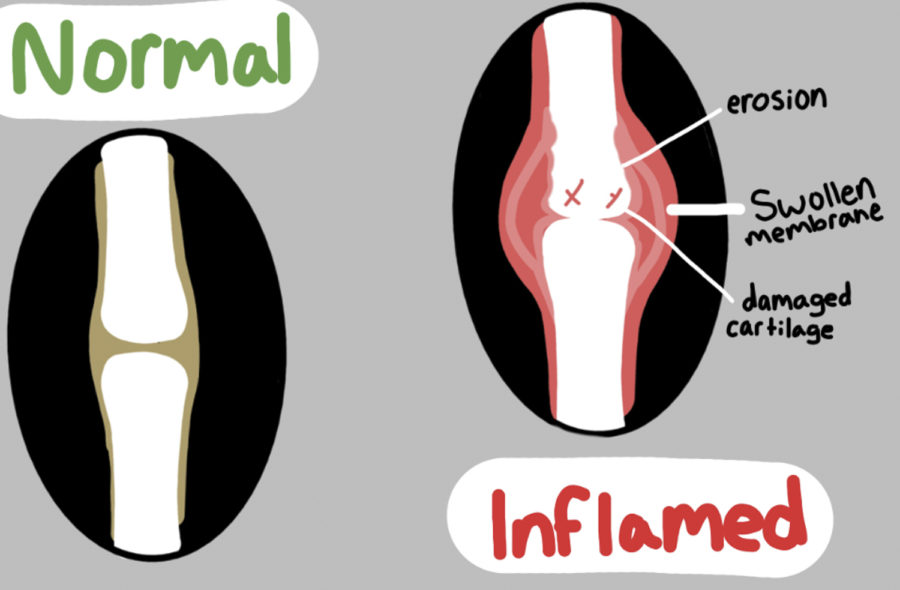Newly discovered protein helps rheumatoid arthritis symptom
Rheumatoid arthritis associated with reduced lifespan, requires expensive therapies
Rheumatoid arthritis causes inflamed joints. Over time, the disease affects vital organs, like the heart and liver, as well.
April 22, 2021
WSU researchers discovered a protein that will help treat chronic inflammation resulting from rheumatoid arthritis.
They found a protein called GBP5 in tissue cells from diseased joints affected by rheumatoid arthritis, said Salah Ahmed, professor in the WSU College of Pharmacy and Pharmaceutical Sciences.
The cells collected from the arthritic joints were tested in a lab, and GBP5 was found to have anti-inflammatory properties similar to cells found in other autoimmune diseases, said Mahamudul Haque, WSU postdoctoral research associate and co-author of the study.
“This discovery adds to our understanding of what are the factors that may play an important role in causing inflammation and tissue destruction,” Ahmed said. “We are also, at the same time, identifying some of the proteins or genes that are produced by the system in response to inflammation.”
More research needs to take place before concluding if the protein displays anti-inflammatory properties in other cell types, or if it is just specific to certain cell types that contribute to inflammation, Haque said.
The GBP5 protein demonstrates anti-inflammatory properties in other immune cell types that play important roles in the development of rheumatoid arthritis, Ahmed said.
The team is working to further define the role of the protein in arthritis, Ahmed said.
With the information collected, the team plans to improve targeted therapeutic approaches and treatments for rheumatoid arthritis and possibly other inflammatory diseases, Ahmed said.
The underlying mechanisms of the protein still need to be understood, like how the protein controls inflammation and the other cell types it can affect, Ahmed said.
“Only the success of future studies will help us understand the bigger impact of this protein,” Ahmed said.
Ahmed said more than 1.5 million people have been diagnosed with rheumatoid arthritis in the United States. There are many types of arthritis, but rheumatoid arthritis is an autoimmune form, which causes tissue destruction and inflammation.
“It is causing disability to work and requires very expensive therapies,” Ahmed said. “Management of [rheumatoid] arthritis is a big socioeconomic challenge.”
Haque said chronic inflammation in rheumatoid arthritis is associated with a reduced lifespan of several years as it is a progressive disease.
“It not only affects the bones of the joints but over time it affects other vital organs like the heart and liver,” he said.
In the early stages of their research, the team tested whether the protein is produced in response to inflammation or if it assists in causing diseased tissue, Ahmed said.
Researchers observed that the protein is produced as a defense mechanism to help reduce inflammation and, in doing so, protects cells affected by arthritis, Ahmed said. When the protein was removed from a living system, other inflammatory proteins caused greater tissue destruction and inflammation.
The research on the protein began in 2015 when Haque joined Ahmed’s lab as a graduate student, Ahmed said. Haque has since graduated and is now working as a postdoctoral research fellow.
The protein was originally discovered in the late 1990s for its role in fighting bacterial infections, Ahmed said.
“But this is the first study that defines [the GBP5 protein’s] role as an anti-inflammatory, as well as its role in any autoimmune disease, not infectious disease or antiviral disease,” he said.
Haque said he is interested in exploring the function of the protein in rheumatoid arthritis. He would like to uncover how the protein works in other autoimmune diseases through further experimentation with lab rats.
“We are just waiting to develop a proposal based on these findings to explore the role of this protein, or gene, in other preclinical rodent models of rheumatoid arthritis that mimic autoimmune response observed in patients,” Ahmed said.










